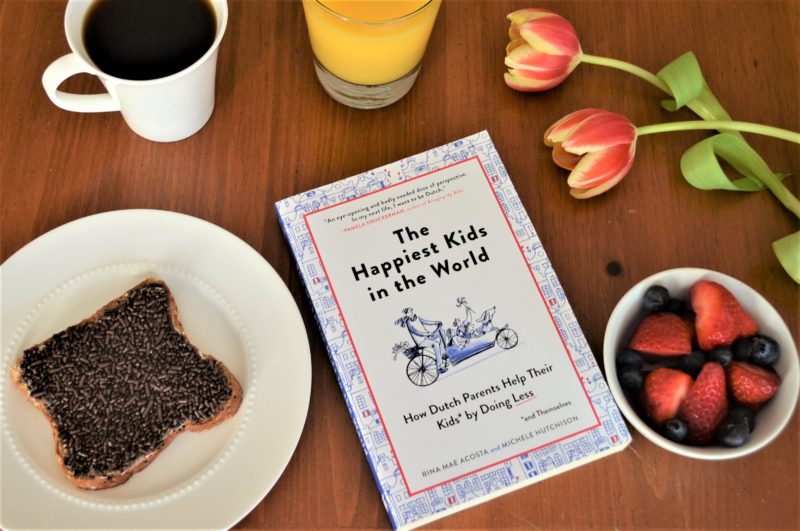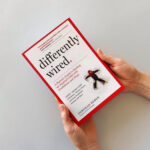Excerpted from The Happiest Kids in the World: How Dutch Parents Help Their Kids (and Themselves) by Doing Less © 2017 by Rina Mae Acosta and Michele Hutchison. Published with permission of The Experiment.

It’s all about the Hagelslag
Lazy Sundays are an absolute must in our household. In any case, most places are closed, or open only in the afternoon—if you’re lucky. Bram will be busy in the kitchen, preparing an elaborate breakfast, and I’ll be on the couch in the living room, breastfeeding Matteo and planning our afternoon nature walk. Julius will be in his room, playing on his own with his Duplo.
Today, the morning sunshine and crisp fall air outside have put us in a good mood. Bram is making wentelteefjes, the Dutch version of French toast, which he serves with goat cheese and strawberries, mango and blueberries. I’m looking up local trails on which to hunt for fly agaric, those elusive red mushrooms with white dots on them. Until I moved to the Netherlands, I thought that these red mushrooms belonged in the fantasy world of Super Mario Brothers, in fairy tales, or with garden gnomes. It turns out they grow plentifully here, and are known for their toxicity and hallucinogenic properties. We’re on a mission simply to admire these beauties from a distance.
“My love, take a look at this,” cries out Bram from the kitchen-dining area.
I turn my head toward the table. Julius is sitting in his high chair, an infectious grin on his face. Our three-year-old has helped himself to breakfast. In front of him is a piece of bread piled high with unsalted butter and hagelslag—chocolate sprinkles.
“No wonder Dutch kids are the happiest kids in the world,” I think to myself. “Who wouldn’t be happy if they could have chocolate first thing every morning?”
I can already hear gasps of disapproval and disdain from the perfect moms of the internet. Chocolate for breakfast? You wouldn’t think that starting the morning with a sugar rush would be a brilliant idea. And he’s created a horrible mess. Butter is smeared all over his high chair, as well as his face and hands, and there are chocolate sprinkles all over the floor.
My husband and I look at each other. Shall we reprimand him? Instead, we burst out laughing and count it as another sanctimommy fail. Oblivious, Julius starts gobbling his hagelslag sandwich, and my husband snaps a picture of his happy face.
Breakfast of champions
So is there something special about eating hagelslag for breakfast? Is that really what makes Dutch children so happy? Judging by the reactions of American kids on a fascinating Buzzfeed video inviting them to try traditional breakfasts from around the world, it was clear that this Dutch breakfast had won their hearts. What kid wouldn’t want to eat breakfast every morning if chocolate was on the menu? But kids in other countries also eat sugar-laden foods, often in the form of cereal—Coco Pops spring to mind. No, I think it’s more about the fact that the Dutch eat breakfast as a family.
According to the 2013 UNICEF report—the one that suggested that Dutch kids were the happiest in the world—85 percent of the Dutch children aged eleven, thirteen and fifteen surveyed ate breakfast every day. Sitting down to eat around the table as a family, before school and the working day, is a routine that underpins Dutch family life. In no other country do families eat breakfast together as regularly as they do in the Netherlands. I’m aware that, in American and British families, breakfast is a meal that’s often skipped altogether, in the rush to get out of the house on time.
What the Dutch seem to understand is the importance of eating regular meals, starting with the meal that breaks the nighttime fast. There’s an abundance of research that points out the benefits of having breakfast every morning: It’s said to reduce the risk of snacking on unhealthy foods throughout the day, decrease the risk of obesity and increase a child’s ability to concentrate at school. The Dutch are champions of breakfast time and seem to be happier and healthier because of it. But the real point is that they put as much value on the idea of starting the day together around the breakfast table, a calming and bonding experience for all the family.
A healthy, balanced diet?
I was surprised that chocolate sprinkles are the centerpiece of breakfast across the Netherlands. Didn’t the Dutch know about the importance of a well-balanced diet low in fat and sugar? It’s true the Dutch have built a reputation, especially among expats, of preparing and eating stodgy, uninspiring food. Perhaps the best way to describe the Dutch approach to eating is that it’s utilitarian: Foods should be easy and quick to prepare, affordable and nutritious. The only difference between a typical Dutch lunch and a typical Dutch breakfast is the three hours in between: Both are based on open sandwiches. Dinner, the only meal that is eaten hot, is often referred to as the holy trinity of meat, a vegetable and a carbohydrate. Haute cuisine it ain’t.
Yet, according to recent research, the Dutch no-nonsense approach to eating may be the way to go. An Oxfam study undertaken in 2014 declared that the Netherlands had “the best food in the world.” Oxfam, an organization working to fight global poverty, looked at four criteria: whether there was a plentiful supply of food, how affordable it was, whether it was good quality, and whether it caused high rates of obesity and diabetes. The UK came in tenth. The US was way below, in twenty-first place, because although food in the US scored high in affordability and quality, the country’s ranking was brought down by the high incidence of obesity and diabetes.
The UNICEF report supports Oxfam’s claim. Dutch children had the lowest obesity rates of all the twenty-nine industrialized countries surveyed. Only 8.36 percent of Dutch children aged eleven, thirteen and fifteen were deemed obese. Sadly, in every country except for three—the Netherlands, Denmark and Switzerland—childhood levels of obesity are now over 10 percent. The results show that the best place to eat in the world is not France, somewhere in the Mediterranean, or Japan, but right here in the Netherlands. In spite of all that butter, bread and hagelslag, the Dutch eat a healthy, balanced diet that’s pretty much affordable to everyone.
This morning, as we watch our toddler happily eat his Dutch breakfast, his head swaying blissfully from side to side, his legs kicking to and fro, I finally realize what hagelslag is all about. Pausing for a moment and just looking at him, silencing all the neurotic and anxious voices in my head, I understand that, apart from his obvious enjoyment of the sweet taste of chocolate, my three-year-old son is content and proud to be able to choose and prepare his own breakfast. This translates into self-confidence. It really is all about the hagelslag.
Want more? Check out the book!
 About the Book
About the Book
Discover how Dutch parents raise The Happiest Kids in the World!
Calling all stressed-out parents: Relax! Imagine a place where young children play unsupervised, don’t do homework, have few scheduled “activities” . . . and rank #1 worldwide in happiness and education. It’s not a fantasy—it’s the Netherlands!
Rina Mae Acosta and Michele Hutchison—an American and a Brit, both married to Dutchmen and raising their kids in the Netherlands—report back on what makes Dutch kids so happy and well adjusted. Is it that dads take workdays off to help out? Chocolate sprinkles for breakfast? Bicycling everywhere?
Whatever the secret, entire Dutch families reap the benefits, from babies (who sleep 15 hours a day) to parents (who enjoy a work-life balance most Americans only dream of). As Acosta and Hutchison borrow ever-more wisdom from their Dutch neighbors, this much becomes clear: Sometimes the best thing we can do as parents is . . . less!
Buy the Book
Amazon | B&N | Indiebound | Workman





No Comments